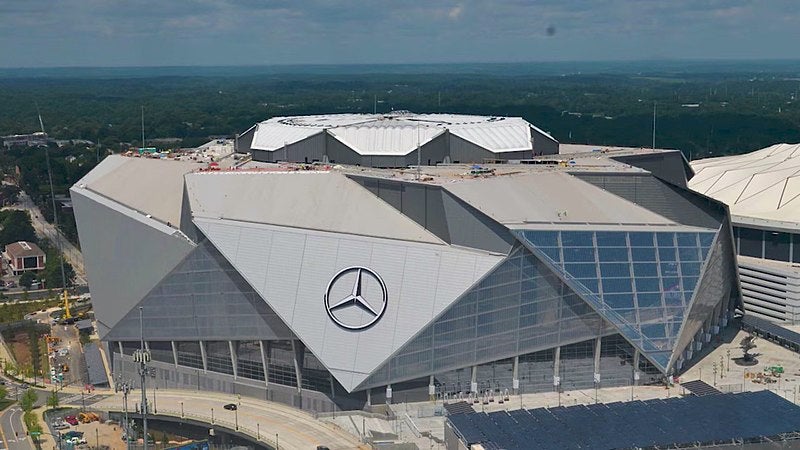
Sports stadiums require a huge amount of power, in particular on match-days when lighting, air-conditioning and video screens all electricity, along with a vast multitude of other energy-intensive demands. Even when not in use, stadiums and other sporting arenas need large amounts of power for maintenance.
The possibilities for incorporating renewable energy technology into stadiums and the surrounding areas provide a huge opportunity for reducing greenhouse gas emissions. This can include placing solar panels on roofs and on the roads leading towards the arenas.
Best stadiums for renewable energy: A focus on the future
As energy-smart stadiums increasingly become the norm, we take a look at those sports arenas giving us a glimpse of the stadium of the future.
Lusail Stadium, Qatar
The Lusail Stadium in Qatar, will host the 2022 World Cup Final. When completed it will have a capacity of 80,000 seats according to architects Fosters+Partners.
The stadium will be solar powered, which in particular will be used to maintain temperatures inside the stadium. Air-conditioning will be used to reduce the temperature to 27°C at a time when the actual temperature outside is 40°C plus.
Solar energy will also be generated from the car park canopies, this will initially power the stadium and the surrounding areas when the ground is not in use. The solar power will lower the stadiums CO₂ emissions by 40%.
Antalya Stadium, Turkey
Antalya Stadium is the home of Turkish football team Antalyaspor. The stadium was built in 2015 in the hope that Turkey would secure the 2024 European championships and has a capacity of 32,000 people. The stadium is Turkey’s first solar-powered stadium.
The roof is 16,000 square meters, and 75% of this area is covered with solar panels. In total there are 6000 panels, enough to generate 7,200-kilowatt hours (KWh) of energy a day. When the stadium is not in use, the power is offset elsewhere.
Tokyo Olympic Stadium, Japan
The Tokyo Olympic Stadium will host the next Olympic Games in 2020. The Japanese government has already stated that it will be a carbon neutral games and will apply the UN’s 17 sustainable development goals.
Solar panels are being incorporated into the design of the stadium. According to the architect Kengo Kuma, the solar panels will be attached to the roof and visible to spectators as they are “looking to make this environmental technology very visible as part of the design.” It will also power the watering of the plants and greenery that surrounds the stadium.
Mercedes-Benz Stadium, America
The remarkable Mercedes-Benz arena cost $1.6bn when it was constructed in 2017, for American football team Atlanta Falcons and Major League Soccer team Atlanta United FC.
In collaboration with Georgia Power, over 4,000 solar panels were installed at the stadium and surrounding area. The panels were installed above car parks at the arena, at the stadium entry gates and on the Georgia World Congress Centre, which forms part of the complex
The project was developed over the course of three separate phases and should provide 1.6m kWh of electricity per year once complete.
Stadio della Roma, Italy
The Stadio della Roma is the long-delayed new stadium for Serie A side AS Roma. Having suffered from innumerable delays and allegations of bribery, the stadium is now expected to be completed by 2023.
The stadium is being built according to the international standards set by LEED and GBC. According to the stadium website, solar panels will be installed on all roof areas, of all of the buildings involved in the project including the stadium roof. The project exceeds local and national targets for renewable energy generation.
Ashton Gate Stadium, UK
Ashton Gate has been the home of Bristol City FC since 1904. The ground underwent significant renovations in 2016, which included the complete rebuilding of two stands and the renovation of another.
As part of the modernisation of the ground, solar panels were installed in the roof of the stadium. Funded by Bristol City council via a power purchase agreement 460 Vikram 255W panels have been installed, which generate 96MWh of energy a year and save 44,038kg of CO₂ a year, reducing its carbon emissions by 20%.
Bankwest Stadium, Australia
The new Bankwest stadium in the Parramatta suburb of Sydney will be completed this year and be home to A-League football side Western Sydney Warriors and Rugby League team Parramatta Eels.
Once again built to LEED and GBC standards, the stadium will be powered by renewable sources. It will also be lit by the latest LED lighting technology to significantly reduce energy use.
The Bankwest stadium is part of the New South Wales government policy of rebuilding major venues in order to ‘climate proof’ them from extreme weather conditions.
T-Mobile Arena, America
The T-Mobile Arena is a multi-purpose venue in Las Vegas that has been the location for Floyd Mayweather vs Conor McGregor, UFC 200 and ice hockey team Vegas Golden Knights.
The arena uses high-efficiency LED lighting throughout to reduce energy usage, alongside high-efficiency heating systems. Other improvements include a reduction in the use of water and cooling energy used in the building.
Because of these measures the arena has been recognised for its efforts in sustainable energy by winning Leadership in Energy and Environmental Design (LEED) gold certification by the US Green Building Council (GBC), the first in Las Vegas to win the honour.



